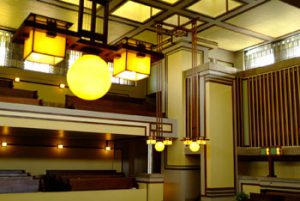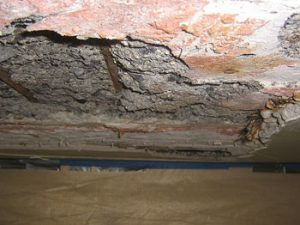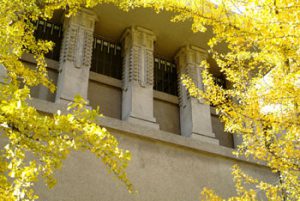Unity Temple, Frank Lloyd Wright’s Modern Masterpiece: An Endangered Treasure
 On Tuesday, April 28, the National Trust for Historic Preservation named Frank Lloyd Wright’s 1909 masterpiece, Unity Temple, to its list of America’s 11 Most Endangered Historic Places. For Unity Temple, this is a significant, though not necessarily joyful, honor. This is a critical time for Unity Temple–a critical crossroads—and to have such a prestigious organization as the National Trust acknowledge Unity Temple’s urgent needs is immensely meaningful. In the year that we celebrate the centennial of the building’s dedication, we may also rejoice that Unity Temple has, in fact, stood the test of time—-albeit with a great deal of love and money—-and still stands here today, unlike so many historic structures that have not been so lucky and are now simply memories: Sullivan’s Schiller Theatre, New York’s Penn Station, the Larkin Building…there are too many to name.
On Tuesday, April 28, the National Trust for Historic Preservation named Frank Lloyd Wright’s 1909 masterpiece, Unity Temple, to its list of America’s 11 Most Endangered Historic Places. For Unity Temple, this is a significant, though not necessarily joyful, honor. This is a critical time for Unity Temple–a critical crossroads—and to have such a prestigious organization as the National Trust acknowledge Unity Temple’s urgent needs is immensely meaningful. In the year that we celebrate the centennial of the building’s dedication, we may also rejoice that Unity Temple has, in fact, stood the test of time—-albeit with a great deal of love and money—-and still stands here today, unlike so many historic structures that have not been so lucky and are now simply memories: Sullivan’s Schiller Theatre, New York’s Penn Station, the Larkin Building…there are too many to name.
 This designation shines a spotlight on the vulnerable condition of Unity Temple. It brings much-needed attention to its significant and urgent restoration needs. True, Unity Temple is not at risk of demolition, nor has it in any sense been ignored or neglected, like others that have been on this list. Just since the year 2000, nearly $3,000,000 has been poured into the building–$700,000 of that from the congregation. The community of supporters has been steadfast and generous, and the restoration effort has been ambitious. All of this has been crucial to the survival of Unity Temple and is the reason it still stands today. This building has been well cared for, but that has not been enough. As architecture critic Paul Goldberger put it, “the deteriorating condition of the building has outpaced the effort to restore it,” and, as a result, Unity Temple’s survival is now endangered.
This designation shines a spotlight on the vulnerable condition of Unity Temple. It brings much-needed attention to its significant and urgent restoration needs. True, Unity Temple is not at risk of demolition, nor has it in any sense been ignored or neglected, like others that have been on this list. Just since the year 2000, nearly $3,000,000 has been poured into the building–$700,000 of that from the congregation. The community of supporters has been steadfast and generous, and the restoration effort has been ambitious. All of this has been crucial to the survival of Unity Temple and is the reason it still stands today. This building has been well cared for, but that has not been enough. As architecture critic Paul Goldberger put it, “the deteriorating condition of the building has outpaced the effort to restore it,” and, as a result, Unity Temple’s survival is now endangered.
 For Wright, Unity Temple marked a time of transition, both personal and professional. For the remaining fifty years of his life he marveled at what he was able to achieve with this building. Scholars have long recognized Unity Temple’s radical design and materiality as ground-breaking. Many say that architecture is what it is today because of Wright’s willingness to venture into new territory—-would Frank Gehry’s Bilbao museum exist without Unity Temple? Would there be a Bird’s Nest Olympic Stadium? Unity Temple’s influence, no doubt, has been powerful.
For Wright, Unity Temple marked a time of transition, both personal and professional. For the remaining fifty years of his life he marveled at what he was able to achieve with this building. Scholars have long recognized Unity Temple’s radical design and materiality as ground-breaking. Many say that architecture is what it is today because of Wright’s willingness to venture into new territory—-would Frank Gehry’s Bilbao museum exist without Unity Temple? Would there be a Bird’s Nest Olympic Stadium? Unity Temple’s influence, no doubt, has been powerful.
Yet it was an innovative design that presented problems from the beginning. For example, our structural engineer tells us that the concrete walls, built without expansion joints, began to crack as soon as they were poured. So now, once again, Unity Temple finds itself at a crossroads – a transition point.
UTRF believes that 2009 is an auspicious year for Unity Temple—it is the centennial year. In detailed studies and the master plan, our architects and engineers have told us what needs to be done:
- Complete emergency repairs to the sanctuary’s south roof slab this summer. This will ensure the slab’s structural safety. The cost is an estimated $550,000, of which $200,000 will come from the Save America’s Treasures challenge grant we were awarded in December. That means we must have more than $300,000 in place by the end of June in order to begin work.
- Over the next two years, raise $2 million to stabilize the rest of the roof, and, by 2013, another $4.5 million for the balance of the concrete work, bringing the total cost of stabilizing the concrete structure to nearly $7 million.
- $1.5 million is required to install the energy and (long-term) money-saving geothermal HVAC system, for which construction drawings will be completed this summer.
- Restore the interior, the cost is estimated to run $13 million.
- The total cost of the restoration is an estimated $20-25 million.
This designation says, “Unity Temple is a treasure in need of and worth saving.” The need is great; the challenge is pressing. Many of us already know this, and now many, many more will. And for that reason—-for the potential that a broader community will learn of Unity Temple’s vulnerable condition and will be moved to donate to support the restoration–we are immensely grateful. Unity Temple Restoration Foundation looks forward to celebrating the centennial of Unity Temple with the international community, and to working together to save Unity Temple.
To learn more about Unity Temple, Frank Lloyd Wright’s modern masterpiece, visit Unity Temple Restoration Foundation website at www.utrf.org. To support the restoration of Unity Temple, visit www.utrf.org and click on “Support.”
–Emily Roth, Executive Director, Unity Temple Restoration Foundation